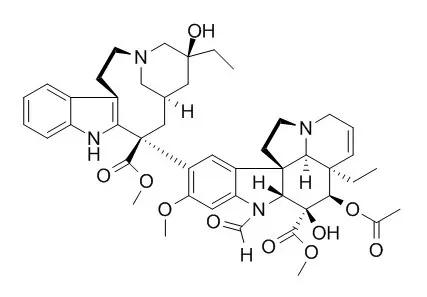| Description: |
Vincristine-induced nociceptive painful sensation, may be due to its potential of antioxidative, neuroprotective and calcium channel inhibitory action.Vincristine can treat MM, ERK1/2, Akt, and NF-κB inhibitors are potentially useful as anti-MDR agents for the treatment of Vincristine-resistant MM. An inherited polymorphism in the promoter region of CEP72 was associated with increased risk and severity of Vincristine-related peripheral neuropathy. |
| In vivo: |
| Toxicol Ind Health. 2014 Oct;30(9):794-805. | | Ameliorative effect of Vernonia cinerea in vincristine-induced painful neuropathy in rats.[Pubmed: 23081859] | The present study was designed to investigate the antinociceptive potential of Vernonia cinerea (VC) on Vincristine-induced painful neuropathy in rats.
METHODS AND RESULTS:
A chemotherapeutic agent, Vincristine (50 μg/kg intraperitoneally for 10 consecutive days), was administered for the induction of neuropathic pain in rats. The painful behavioral changes were assessed using hot plate, acetone drop, paw pressure, Von Frey hair and tail immersion tests to assess the degree of hyperalgesic and allodynic pain sensation in paw and tail. Tissue biomarker changes including thiobarbituric acid reactive substances (TBARSs), reduced glutathione (GSH) and total calcium levels were estimated in sciatic nerve tissue samples to assess the degree of oxidative stress. Histopathological changes were also observed in transverse sections of rat sciatic nerve tissue. Ethanolic extract of VC leaves and pregabalin were administered for 14 consecutive days from day 0 (day of surgery). Pregabalin served as a positive control in the present study. Vincristine administration resulted in a significant reduction in painful behavioral changes along with a rise in the levels of TBARS, total calcium and decrease in GSH levels when compared with the normal control group. Furthermore, significant histopathological changes were also observed.
CONCLUSIONS:
Pretreatment with VC significantly attenuated Vincristine-induced development of painful behavioral, biochemical and histological changes in a dose-dependent manner, which is similar to that of pregabalin-pretreated group. The attenuating effect of VC in Vincristine-induced nociceptive painful sensation may be due to its potential of antioxidative, neuroprotective and calcium channel inhibitory action. | | JAMA. 2015 Feb 24;313(8):815-23. | | Association of an inherited genetic variant with vincristine-related peripheral neuropathy in children with acute lymphoblastic leukemia.[Pubmed: 25710658] | To identify genetic germline variants associated with the occurrence or severity of Vincristine-induced peripheral neuropathy in children with ALL.
METHODS AND RESULTS:
Genome-wide association study of patients in 1 of 2 prospective clinical trials for childhood ALL that included treatment with 36 to 39 doses of Vincristine. Genome-wide single-nucleotide polymorphism (SNP) analysis and Vincristine-induced peripheral neuropathy were assessed in 321 patients from whom DNA was available: 222 patients (median age, 6.0 years; range, 0.1-18.8 years) enrolled in 1994-1998 in the St Jude Children's Research Hospital protocol Total XIIIB with toxic effects follow-up through January 2001, and 99 patients (median age, 11.4 years; range, 3.0-23.8 years) enrolled in 2007-2010 in the Children's Oncology Group (COG) protocol AALL0433 with toxic effects follow-up through May 2011. Human leukemia cells and induced pluripotent stem cell neurons were used to assess the effects of lower CEP72 expression on Vincristine sensitivity. Treatment with Vincristine at a dose of 1.5 or 2.0 mg/m2. Vincristine-induced peripheral neuropathy was assessed at clinic visits using National Cancer Institute criteria and prospectively graded as mild (grade 1), moderate (grade 2), serious/disabling (grade 3), or life threatening (grade 4). Grade 2 to 4 Vincristine-induced neuropathy during continuation therapy occurred in 28.8% of patients (64/222) in the St Jude cohort and in 22.2% (22/99) in the COG cohort. A SNP in the promoter region of the CEP72 gene, which encodes a centrosomal protein involved in microtubule formation, had a significant association with Vincristine neuropathy (meta-analysis P = 6.3×10(-9)). Reducing CEP72 expression in human neurons and leukemia cells increased their sensitivity to Vincristine.
CONCLUSIONS:
In this preliminary study of children with ALL, an inherited polymorphism in the promoter region of CEP72 was associated with increased risk and severity of Vincristine-related peripheral neuropathy. If replicated in additional populations, this finding may provide a basis for safer dosing of this widely prescribed anticancer agent. |
|






 Cell. 2018 Jan 11;172(1-2):249-261.e12. doi: 10.1016/j.cell.2017.12.019.IF=36.216(2019)
Cell. 2018 Jan 11;172(1-2):249-261.e12. doi: 10.1016/j.cell.2017.12.019.IF=36.216(2019) Cell Metab. 2020 Mar 3;31(3):534-548.e5. doi: 10.1016/j.cmet.2020.01.002.IF=22.415(2019)
Cell Metab. 2020 Mar 3;31(3):534-548.e5. doi: 10.1016/j.cmet.2020.01.002.IF=22.415(2019) Mol Cell. 2017 Nov 16;68(4):673-685.e6. doi: 10.1016/j.molcel.2017.10.022.IF=14.548(2019)
Mol Cell. 2017 Nov 16;68(4):673-685.e6. doi: 10.1016/j.molcel.2017.10.022.IF=14.548(2019)